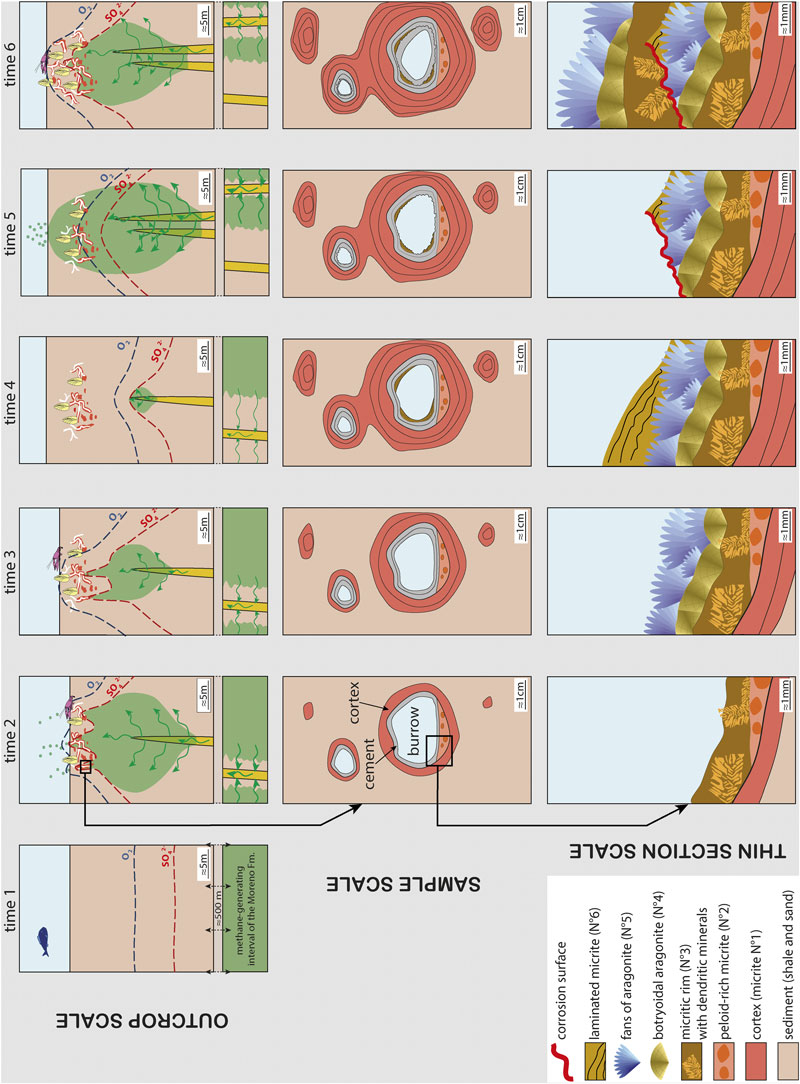The AAPG/Datapages Combined Publications Database
AAPG Bulletin
Figure
AAPG Bulletin; Year: 2017; Issue: August DOI: 10.1306/10171616021
Return to Full Text

Figure 15. Evolution of methane seepage flux and seep carbonate precipitation through time from outcrop (meters) to thin-section scale (millimeters). Time 1: Initial state of the sediment, before injectite propagation. Burrows are absent. Time 2: After the rapid injectite propagation and drop of pressure of the injectite network to the hydrostatic regime (below the pressure of the Moreno shale), methane is expelled out of the shale and rises through the network up to the surface. The high methane flux pushes the sulfate–methane transition zone (SMTZ) upward. Simultaneously, chemosynthetic organisms settle and thrive in this methane-rich environment, burrowing and producing pellets. The intense anaerobic oxidation of methane triggers the precipitation of dendritic minerals while methane diffusion from the burrows to the surrounding sediment initiates the precipitation of the cortex. Time 3: The Moreno shale is progressively depleted in gas, and the flux of methane in the injectites reduces. Consequently, the SMTZ moves back downward, and the elementary sequence (ES) precipitates. Time 4: Once the gas-charged shale surrounding the injectite network is significantly depleted, the upward flux of methane deactivates, and diagenetic interfaces move back close to their original position. Time 5: Reactivation of the injectite network in undepleted sections of the Moreno Formation (Fm.) triggers a new phase of gas migration. Because of the sudden and intense rising flux of methane, gas propagates up to oxic sediment and aerobic oxidation of methane takes place, thus promoting carbonate dissolution. Time 6: A new cycle begins: a new ES precipitates while the shale of the Moreno Fm. depletes.

Figure 15. Evolution of methane seepage flux and seep carbonate precipitation through time from outcrop (meters) to thin-section scale (millimeters). Time 1: Initial state of the sediment, before injectite propagation. Burrows are absent. Time 2: After the rapid injectite propagation and drop of pressure of the injectite network to the hydrostatic regime (below the pressure of the Moreno shale), methane is expelled out of the shale and rises through the network up to the surface. The high methane flux pushes the sulfate–methane transition zone (SMTZ) upward. Simultaneously, chemosynthetic organisms settle and thrive in this methane-rich environment, burrowing and producing pellets. The intense anaerobic oxidation of methane triggers the precipitation of dendritic minerals while methane diffusion from the burrows to the surrounding sediment initiates the precipitation of the cortex. Time 3: The Moreno shale is progressively depleted in gas, and the flux of methane in the injectites reduces. Consequently, the SMTZ moves back downward, and the elementary sequence (ES) precipitates. Time 4: Once the gas-charged shale surrounding the injectite network is significantly depleted, the upward flux of methane deactivates, and diagenetic interfaces move back close to their original position. Time 5: Reactivation of the injectite network in undepleted sections of the Moreno Formation (Fm.) triggers a new phase of gas migration. Because of the sudden and intense rising flux of methane, gas propagates up to oxic sediment and aerobic oxidation of methane takes place, thus promoting carbonate dissolution. Time 6: A new cycle begins: a new ES precipitates while the shale of the Moreno Fm. depletes.